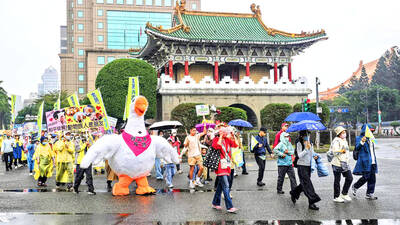French director Luc Besson’s new action thriller Lucy opened in Taiwan yesterday, with the film’s local distributor estimating that it would break the NT$24 million (US$800,280) mark on the first day of its local release.
Universal Studios Inc has also predicted that the film’s first-week gross will reach NT$125 million, but said an accurate figure for the first-day box office gross will not be available until the next day.
The film, starring US actress Scarlett Johansson, is something of a rarity — one of the few major Hollywood productions to be shot mainly in Taiwan.

Photo: CNA
Of the film’s 89-minute running time, more than half takes place against Taipei landmarks, showing off sites such as the Taipei 101 skyscraper, the Taipei Railway Workshop and the Regent Taipei hotel.
Even the country’s national flag gets a showing, not an easy feat given China’s attempts to isolate Taiwan.
The film also depicts one of the city’s best-known delicacies — steamed dumplings called xiaolongbao.
Johansson plays the leading role as an American woman living and studying in Taipei who is forced to become a drug mule for gangsters.
She is accidentally exposed to the drug, which unlocks the “full potential of her brain” and transforms her into a superhuman fighting machine.
The movie has helped boost Taiwan’s popularity amid the country’s efforts to bring itself to the world stage, the Wall Street Journal said in a report on Tuesday.
While different sites in Taiwan have appeared in foreign films before, none have put Taipei front and center stage like Lucy , the article said.
“Scarlett Johansson may be the leading lady in French director Luc Besson’s new thriller Lucy , but for many Taiwanese movie watchers, the film’s real star is the city of Taipei,” it said.
The Taipei Film Commission, which played a significant role in persuading Besson to film in the city, was cited as saying that since 2008, 267 foreign films have shot scenes in Taipei and the trend is expected to grow.

NUMBERS IMBALANCE: More than 4 million Taiwanese have visited China this year, while only about half a million Chinese have visited here Beijing has yet to respond to Taiwan’s requests for negotiation over matters related to the recovery of cross-strait tourism, the Tourism Administration said yesterday. Taiwan’s tourism authority issued the statement after Chinese-language daily the China Times reported yesterday that the government’s policy of banning group tours to China does not stop Taiwanese from visiting the country. As of October, more than 4.2 million had traveled to China this year, exceeding last year. Beijing estimated the number of Taiwanese tourists in China could reach 4.5 million this year. By contrast, only 500,000 Chinese tourists are expected in Taiwan, the report said. The report

Temperatures are forecast to drop steadily as a continental cold air mass moves across Taiwan, with some areas also likely to see heavy rainfall, the Central Weather Administration (CWA) said. From today through early tomorrow, a cold air mass would keep temperatures low across central and northern Taiwan, and the eastern half of Taiwan proper, with isolated brief showers forecast along Keelung’s north coast, Taipei and New Taipei City’s mountainous areas and eastern Taiwan, it said. Lows of 11°C to 15°C are forecast in central and northern Taiwan, Yilan County, and the outlying Kinmen and Lienchiang (Matsu) counties, and 14°C to 17°C

STEERING FAILURE: The first boat of its class is experiencing teething issues as it readies for acceptance by the navy, according to a recent story about rudder failure The Hai Kun (海鯤), the nation’s first locally built submarine, allegedly suffered a total failure of stern hydraulic systems during the second round of sea acceptance trials on June 26, and sailors were forced to manually operate the X-rudder to turn the submarine and return to port, news Web site Mirror Daily reported yesterday. The report said that tugboats following the Hai Kun assisted the submarine in avoiding collisions with other ships due to the X-rudder malfunctioning. At the time of the report, the submarine had completed its trials and was scheduled to begin diving and surfacing tests in shallow areas. The X-rudder,

DEMAND: The government should enact regulations in line with Austria and Germany to incorporate vegan nutrition into school meals, an advocate said More than 1,000 people yesterday marched in Taipei to promote veganism, calling for legislation to incorporate vegan diets into school lunches and the national net zero emissions program. Participants gathered on Ketagalan Boulevard in front of the Presidential Office Building for the march, which was organized by the Vegan Action Network (VAN). Former ambassador to Chad Chiu Chung-jen (邱仲仁), actor Yankee Yang (楊子儀) and actress Cindy Lien (連俞涵) attended the event. VAN member Marianne Chao (趙梅君) said that the campaign aimed to urge the government to promote vegan diets across schools and government agencies via legislation and national policies, which would help build